Peer assessment and Computer Literacy for Junior High School Students in Geography Lessons in Hong Kong
Adam Wong
Hong Kong Polytechnic University, Hong Kong
Helena Ng
Wah Yan College, Hong Kong
ABSTRACT
This is a practical experience in adopting an interdisciplinary approach to teaching geography to junior high school students. Some computer literacy lessons were given to 166 grade eight students for a geography assignment. The students submitted their work onto a central server at school using secure file transfer software. Then the students assessed one another's work using an online survey tool. The results revealed that in general, the students were satisfied with the use of online assignment submission and networked peer assessment. Recommendations were made at the end for similar attempts.
Keywords: Peer assessment, Computer Literacy, High School, Student Satisfaction, Geography
INTRODUCTION
Learners today are faced with the issue of information explosion. In order to better prepare our high school students for further studies or for work, it is not sufficient to just teach them subject-specific knowledge in the traditional way. To truly meet the needs of students, a high school should provide varied teaching and learning approaches and deliver a curriculum that is challenging, integrative, and exploratory (National Middle School Association 1995). However, in most high schools, computer skills are taught in computer classes and therefore the students learn them out-of-context (Eisenberg et al. 2004:8). It is recommended that when designing the curriculum, schools should "focus on learning with technology, not about technology" (President's Committee of Advisors on Science and Technology Panel on Educational Technology 1997). This study documents an interdisciplinary approach to doing geography peer-assessment and teaching basic computer literacy at the same time. It attempts to find out the attitude of junior high school student toward online assignment submission and networked peer-assessment.
In this study, a geography teacher taught 166 students some basic computer literacy skills so that the students could do online assignment submission and networked peer-assessment in a manageable manner. The tools used were general purpose software that the students could apply in other subjects. It was found that the students could apply the basic computer literacy skills in their geography assignments. Also, most of them had positive attitudes toward online assignment submission and networked peer assessment. The names of the software tools and some recommendations are provided to teachers who intend to try the same at their schools.
Structure of the Report
First, we will give some background of the school and students. Then we will describe how the teacher helped the students build up some basic computer literacy skills. After that, we will explain the steps of online assignment submission and networked peer assessment. Then the results of a survey on their perceptions will be discussed. Finally, we will conclude the experience gained from this study and make some recommendations to whoever wants to attempt the same in their institutions.
The School
The students in this study were in the second year of secondary education (equivalent to grade 8 in North America) in a boy's school in Hong Kong. The students were male Chinese students aged between 13 and 14. There are totally 1255 students and 50 teachers in this school. In terms of number of students and teachers, there is a very typical secondary school in Hong Kong. There were no computer literacy subjects in most primary schools nor in the first two years of the high school in HK, so the students did not have many competencies in using computers in general or how to collect and organize information using digital media in particular. They usually just accessed the school intranet to look at announcements and download handouts. On campus, there were two computer rooms and the geography room also had computers installed. Geography was a compulsory subject taken by all high school students in the first and second years.
Peer assessment
Peer assessment is known to have positive effects on student satisfaction and learning effectiveness in different disciplines in higher education (Searby & Ewers 1997; Stanier 1997; Gatfield, 1999; Hafner & Hafner 2003) . Lin et al. (2002) pointed out that w hile the validity and reliability of peer assessment in higher education has been well explored, researches on the feasibility and student satisfaction on peer assessment in high schools are rare.
On the other hand, managing the peer assessment process itself can be a challenge, especially when the work being assessed are paper-and-pen assignments, Isaacs (1998) mentioned that if the students' work were allowed to be taken out of the classroom, the distribution of student's work for peer assessment could create a substantial extra workload and logistics problems. Therefore, online assignment submission, in which students upload their work to a central server at school, is an effective way to overcome the logistics problem. In this research, online assignment submission is an integral part of networked peer assessment. While most high schools use some kind of learning management system, a lot of the learning management systems do not support formal assessments (CELT, 2004). So there is a practical constraint that if teachers are going to use online assignment submission and networked peer assessment without too much administrative and training overhead, they are likely to have to use general-purpose software. This constraint was also seen as an opportunity to teach the students some basic computer literacy.
METHOD
While there is purpose-built software for peer assessment (Freeman & McKenzie 2002; Lin et al., 2002), it was decided that general-purpose software would be used. This is because one main purpose of this study is to teach students some tools and skills that they can apply in other subjects or in their future studies or work. So the teacher decided to use only readily available free software that requires minimal training. The tools selected were WinSCP and the web-site FreeOnlineSurvey.com.
Computer literacy Lessons
Two lessons were used to teach the students some computer competencies in computer literacy. In the first lesson, the students were taught how to use the search engines on the Internet to effectively search for information. For example, when they do a search using the keywords "plate tectonics", too many hits are returned and a lot of them might be too difficult for junior high school students. So they were taught to add another keyword "kids", which reduced the hits only to those suitable for junior high school students. Also in the first lesson, the students were taught the basic skills in Microsoft PowerPoint to do simple presentations.
In the second lesson, the students were taught how to organize their presentation, such as including a table of contents, hyperlinks for navigation, and a reference list for acknowledging the source of information. Examples of some student slides are shown in figures 1 and 2. The students were also taught to use a secure file transfer software called WinSCP. Secure file transfer software, such as WinSCP, is required because, for security reasons, the school only allowed remote file transfers through a communication protocol called SSH (Secure SHell). (Boze, 2002) Therefore, the students had to install WinSCP at home before they could remotely and securely logon to the central file server at school and upload their assignment to it for all other students to review.
After these two computer literacy lessons, students were asked to complete an assignment called "Unstable Earth". In that assignment, the students had to search for information related to tsunamis, volcanoes, and earthquakes on the Internet. The students were given a week's time to finish that assignment either at home or using one of the computer labs at school. The students then had to make a Microsoft PowerPoint presentation of the information they had gathered. In order to make their work accessible to their classmates for review, they were asked to upload their presentation to a central server at school using WinSCP.
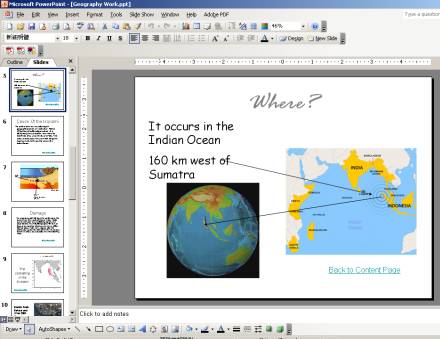
Figure 1: One of the slides of a student's presentation on the tsunami that occurred in December 26, 2004, showing the epicenter of the earthquake that caused the tsunami.
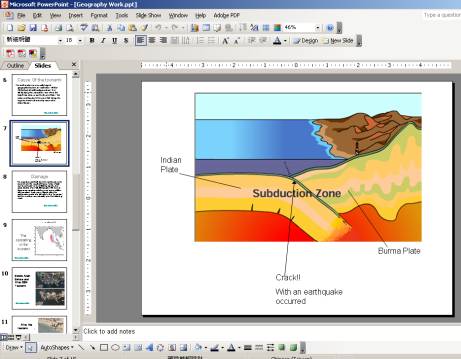
Figure 2: Another slide of the student's presentation showing the plate tectonics movement that caused the earthquake.
Networked Peer Assessment
Peer assessment can be defined as "an arrangement in which individuals consider the amount, level, value, worth, quality, or success of the products or outcomes of learning of peers of similar status." (Topping, 1998). In lesson three, the students assessed the work of their peers by assigning scores using an electronic score sheet. It is important that the students be trained how to assess their peer's work, especially when doing it for the first time (Isaacs, 1998). Firstly, the assessment criteria were explained to the students. As they were junior high school students, the assessment criteria were made quite simple. Yet they contained the same categories and relative weights as the criteria that the teacher would have used if the teacher were to have marked the assessments.
The students were given a hyperlink to a web page containing the names of their classmates. When they clicked on a name, the work of that student was shown as Microsoft PowerPoint slide shows. In order to collect and compile the scores efficiently, the students filled out an electronic form to give the scores to their peers. The electronic form was actually an online survey questionnaire provided by FreeOnlineSurveys.com, with the questions modified so that the question number was the student number whose work was being assessed, and the students' responses represented the score that they gave to their peers (Figure 3). The student assessor remains anonymous.
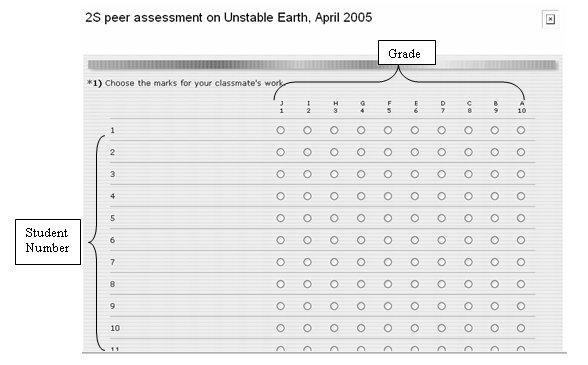
Figure 3: The online survey form that was used as an electronic score sheet. There is only one question. The parts (1,2,3...) of the question on the left represent student numbers. The response choices (radio buttons on the right) represent the score corresponding to a particular student number.
Survey
An online survey was done by inviting the students to fill out a questionnaire right after the peer assessment. The questionnaire consists of both structured questions and open-ended questions to survey the students' attitudes toward the use of online assignment submission and networked peer assessment. The structured questions were rated on a 5-point Likert scale in which:
"1 = Strongly Disagree", "2 = Disagree", "3 = Neutral", "4 = Agree", "5 = Strongly Agree".
The questions are listed below:
- Questions related to online assignment submission:
- Online assignment submission is easy to use
- I prefer online assignment submission to paper submission
- I would like to have more online assignment submissions
- Survey questions concerning peer assessment:
- Peer assessment makes my learning more interesting.
- I can learn from others by looking at their work.
- I can find out my shortcomings by comparing my work with that of others.
- I would like to have more peer assessments.
Open-ended questions were also used to allow the students to freely express their opinions about the overall arrangement of the assignment submission and the peer assessment. The open-ended questions are listed below.
- Please write down the things that you like about online assignment submission and peer assessment.
- Please write down the things that you DO NOT like about online assignment submission and peer assessment.
- Please put down any suggestions and comments that you want to make.
It is of pedagogical interest to find out if the use of computers in a traditional subject will affect student performance. Therefore, for students who performed either very well or very badly in this assignment, the teacher compared the grades of their work with the grades they obtained for their other assignments, which were done entirely using the pen-and-paper approach.
RESULTS AND DISCUSSIONS
Although the participation in the survey was anonymous and optional, the response rate was 71% (118 out of 166). This response rate was similar to another research done on high school students (Lin et al. 2002). The results of the survey and the teacher's observation are presented in the following paragraphs.
Online assignment submissions
Of the 166 students in this research, 30 students did not submit their work on time. So the on-time submission rate was about 82%. This is consistent with the teacher's experience of submission rates in this subject at this level. This means the use of online assignment submission did not cause any hindrance to the students. The results of the survey regarding online assignment submission are summarised in Figures 4 to 6.
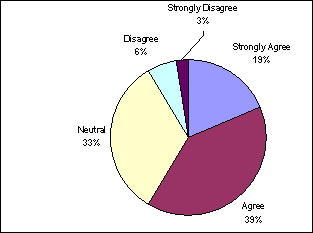
Mean = 3.66; Standard Deviation = 0.94
(1 = Strongly Disagree, ..., 5=Strong Agree)
Figure 4: Student Responses to "Online assignment submission is easy to use"
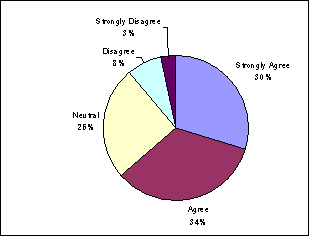
Mean = 3.79; Standard Deviation = 1.06
(1 = Strongly Disagree, ..., 5=Strong Agree)
Figure 5: Student Responses to " I prefer Online Assignment Submission to paper submission "
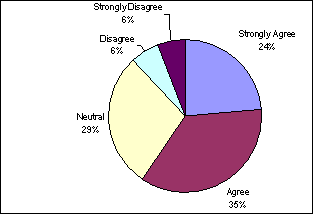
Mean = 3.65; Standard Deviation = 1.09
(1 = Strongly Disagree, ..., 5=Strong Agree)
Figure 6: Student Responses to "I would like to have more Online Assignment Submissions"
Overall, the results indicate that the students have quite positive attitudes toward online assignment submission. From figure 4, more than half (58%) of the students actually agree or strongly agree that online assignment submission is easy to use. The result is consistent with the answers to the next two questions. About 64% (figure 5) of the students prefer to use online assignment submission rather than paper submission. Also, about 59% 63% (figure 6) of the students would actually like to have more online assignment submissions in the future.
Networked Peer Assessment
The results on peer assessment are also encouraging. The actual results are listed in Figures 7 to 10.
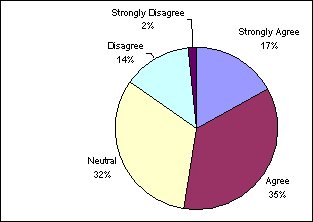
Mean = 3.53; Standard Deviation = 0.98
(1 = Strongly Disagree, ..., 5=Strong Agree)
Figure 7: Student Responses to " Peer assessment makes my learning more interesting. "
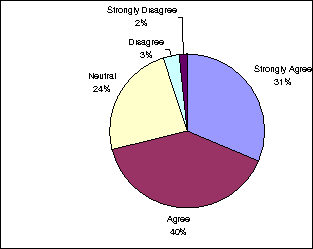
Mean = 3.96; Standard Deviation = 0.92
(1 = Strongly Disagree, ..., 5=Strong Agree)
Figure 8: Student Responses to " I can learn from others by looking at their work. "
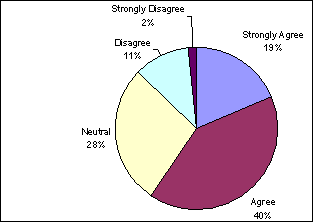
Mean = 3.64; Standard Deviation = 0.97
(1 = Strongly Disagree, ..., 5=Strong Agree)
Figure 9: Student Responses to "I can find out my shortcomings by comparing my work with that of others."
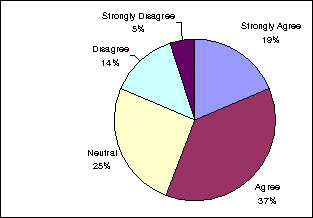
Mean = 3.51; Standard Deviation = 1.10
(1 = Strongly Disagree, ..., 5=Strong Agree)
Figure 10: Student Responses to "I would like to have more peer assessments."
In figure 7, almost half (52%) of the students indicated that peer assessment makes their learning more interesting. This is consistent with the teacher's observation that the students exhibited more enthusiasm than other students when they were taught the same topics in previous years, when no peer assessment was used.
In figure 8, the majority (71%) of the students mentioned that they had actually learnt from others by looking at their work. Interestingly, in figure 9, relatively fewer students (59%) indicated that they could find out their shortcomings by comparing their work with that of others. It seems that the students find it easier to learn from the merits of others; but harder to see they might have made the same or similar mistakes as their peers.
Most of the students were ready to have more peer assessments. In figure 10, less than one-fifth of the students selected "Strongly Disagree" or "Disagree" when they were asked if they would like to have more peer assessments.
When the work of the students who performed very well and very badly in this assignment were compared with their other assignments, which were done using the pen-and-paper approach, it was noted that some students, who normally did not do very well in paper-and-pen assignments, performed surprisingly well on online assignment submission. Conversely, some students who had been quite good at paper-and-pen assignments did not do so well when they had to finish the assignment using almost only computers.
What the Students like about Online Assignment Submission and Peer Assessment
There were 43 valid responses to the question on the things they like about online assignment submission and peer assessment. The convenience of using the computer instead of paper was the most common answer (40%). The second most common response was that using computers made the learning more interesting (35%). The third most common response was that they could learn more by looking at the work done by others (26%). A few students mentioned that online assignment submission was more environmentally friendly (9%). The actual remarks given included the following items:
- It was more convenient than using pen and paper.
- It was funny and interesting.
- It was better to use the computer during lessons.
- I could learn from my classmates.
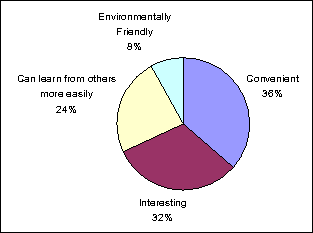
Figure 11: What the Students like about Online Assignment Submission and Peer Assessment
Many students stated that they just liked working with computers. This was consistent with the teacher's observation that most students were more enthusiastic when the lessons involved the use of computers. Many students mentioned that they learnt by reviewing their peers' work. It could be explained as the students could quickly look at and compare the different ways of explaining the same concepts. The teacher was also impressed by the abundance of materials that were so different from what was seen in the textbooks. It was also observed that the students got interested when they saw animations and videos. The students indicated they found online assignment submission very convenient because they could modify their assignments easily and that they could do it even when they were not at home or at school.
The feedback of an assessment should be made known to the student in a timely manner (Isaacs, 2001). Although only a very limited kind of feedback, the scores given by their peers could be shown to the students almost immediately. They were excited when their marks were actually made known to them at the end of the assessment session in the form of numbers and charts. (See Figure 12).
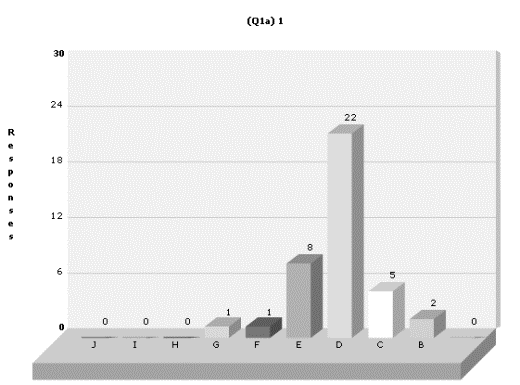
Figure 12: The immediate calculation of scores for students are provided by the online survey tool. It showed 22 of the 37 students in the class gave his work a 7 on a scale from 1 (the worst, represented by the letter J) to 10 (the best, represented by the letter A). The software did not show the letter A because no students gave that score.
What the Students do not like about Online Assignment Submission and Peer Assessment
There were 40 valid responses to the question on what they do not like about online assignment submission and peer assessment. The most common answer (59%) was that the procedure was time consuming. The second most common answer (17%) was that the procedures were hard to follow. The third most common answer (10%) was that the connection to the server through the Internet was unstable. Relatively few (8%) students indicated that the marking done by their peers was unfair. A few (3%) indicated they were distracted by other activities such as playing games on the computer. The actual remarks given included the following items:
- The computer was very slow.
- Spent too much time on navigating the screens.
- My typing was very slow.
- The process was too complex.
- The whole system was unfair because some students gave very low marks.
- Some classmates were just playing computer games.

Figure 13: What the Students do not like about Online Assignment Submission and Peer Assessment
While most students find the idea of online assignment submission interesting, they didn't really like the procedures they had to follow. This is consistent with the findings by Lin et al. (2002). The most common dislike was the long time it took to upload their own work and download their peers' work. This is because the computers in the geography room were not powerful enough by today's' standards. Also, a lot of the students included high-resolution pictures, slides with animations and even videos in their presentations. These exerted extra demand on the power of the computers and the bandwidth of the connections to the Internet.
Some students reluctantly admitted that they didn't have a computer at home – which implied their financial inferiority. The solution was that they had to go to their relative's home to finish the assignment.
Suggestions and comments from students
There were 18 valid responses. Half (50%) of the responses indicated that the procedure should be simplified. About 28% of the responses indicated that they could get used to this type of online assignment submission and peer assessment easily. About 17% of the responses indicated that they needed more computers, faster computers and faster network connections. A few (6%) indicated that they need more time to do the assessment. The actual remarks given included the following items:
- The school should upgrade the computers in the geography room.
- The procedure should be simplified.
LIMITATIONS OF THIS STUDY There were no gender, age or ethnic variations in this research because they were all Chinese, boys of the same age group attending full-time grade eight classes. So we could not infer any differences due to these parameters. However, there were a number of factors that might have limited the validity of this research.
The student whose work was being assessed was not anonymous. This may limit the validity of the scores in the peer assessment because one of the perceived drawbacks of peer assessment is the obstruction of friendship (Williams, 1992). Therefore, the scores from the peer assessment were not included in the students' actual assessment.
The computer literacy of the student and the teacher were important. Many students did not know how to download the software (WinSCP) even they could find the web page. As the teacher was the first to pioneer the use of this method in the school, she encountered many problems that occur when using a new system. If the students had been more computer literate, their attitudes toward online assignment submission might have been better. Actually, some students who were considered rather weak in doing paper-and-pen assignments produced surprisingly good work when online assignment submission was used. This suggested that computer literacy could be one of the factors. In fact, Brag & Busnardo (2004:65) pointed out that computer literacy is a central issue that must be considered by educators who want to use computers as a means for teaching and learning.
Isaacs (1998) pointed out that to minimize logistics problems, the marking should be done in a classroom session (Isaacs, 1998). In this study, the nature of the assignment used in this research contained a lot of visual elements (diagrams, pictures, maps and some videos) put in electronic form because they were mainly collected from the Internet. The combination of electronic presentation of visual elements allowed the assessment to be completed during lesson time. The student attitude could be quite different if they had been asked to assess textual assignments only.
Although assessor feedback would be helpful for the recipients of the assessment to enable them to get to know their strengths and weaknesses, in this research, the assessor only gave numerical scores instead of textual feedback. This is because assessors need special training in giving effective feedback (Isaacs, 1998). Also, if they had been asked to write feedback in text form, they would have needed more time and the assessment could not have been completed during class time. Students doing the assessment and writing feedback at home would have frequently missed the due date set for the assessment task (Isaacs, 1998).
RECOMMENDATIONS Here are some recommendations for teachers and students who intend to do the same in their schools:
- For junior high students, include visual elements in the assignment so that students can easily appreciate each other's work.
- The computer support personnel should set a reasonable limit on file size so that students can upload files containing graphics and animations. If students are forced to ‘hyperlink' to an external web site, it will slow down the peer-assessment process.
- The computer support personnel should assign the same password to students when they login remotely to upload their files using file transfer software such as WinSCP.
- The assessor and the student whose work is being marked should be made anonymous.
- If peers are allowed to give textual feedback electronically, the teacher should review and moderate the feedback.
- It is best to provide computer literacy lessons in the beginning of the school year to allow students to build up their competencies in using computers and in searching, organizing and presenting information.
- Make sure there are enough computer facilities so that less affluent students can finish all the work at school.
- The students must be aware that scores from the peer-assessment will not be given much weight for formal assessment, especially when the students don't have much experience with it.
- The students should adopt a reflection approach to peer-assessment, not a judgmental approach. Otherwise, they might simply focus on giving grades, without seeing how they can improve their own work based on what they see in work of their peers.
CONCLUSIONS
Given the fact that the students lacked basic computer literacy when the study was conducted, the result is very satisfactory. Therefore, it would be an interesting project to track the attitudes of this group of students as they progress to higher grades in high school.
While the size of the population and duration of this study was modest in educational research terms, it does provide some pioneer experience for teachers in schools who also intend to attempt an inter-disciplinary approach in junior high schools.
We can conclude that given suitable training and facilities, junior high school students have positive attitudes towards the use of online assignment submission and networked peer assessment, even if they have to learn some computer literacy skills at the same time.
It is recommended that further research be done, possibly using factor analysis , to understand the factors underpinning the student attitudes towards online assignment submission and networked peer assessment.
As a final note, many students expressed interests in using the FreeOnlineSurvey web site and some had already set up their own surveys!
REFERENCES
Boze, Andy, (2002). "WinSCP 2.0 Beta", Information Technology and Libraries, Chicago, Dec. 2002, Vol. 21(4), pp190-191.
CELT (Center for Enhanced Learning and Teaching) 2004. Secure Online Assessment System , the Hong Kong University of Science and Technology. Available online at http://celt.ust.hk/cli/projects/soas (Accessed June 21, 2005).
Eisenberg and Lowe and Spitzer (2004). Information literacy: essential skills for the information age , Libraries Unlimited, 2nd ed.
Freeman and McKenzie (2002). "SPARK, a confidential web–based template for self and peer assessment of student teamwork: benefits of evaluating across different subjects.", British Journal of Educational Technology, Vol. 33 Issue 5, pp. 551-569.
Gatfield, T. (1999). "Examining Student Satisfaction with Group Projects and Peer Assessment". Assessment and Evaluation in Higher Education Vol. 24(4), pp. 365-377.
Hafner, J. and Hafner, P. (2003). "Quantitative analysis of the rubric as an assessment tool: an empirical study of student peer-group rating". International Journal of Science Education, Vol. 25 Issue 12, pp. 1509-1528.
Isaacs, G. (1998). "Brief briefing: Peer and self assessment", Effective Assessment at University - A conference for staff of the University of Queensland and local universities, The University of Queensland.
Isaacs, G. (2001). "Assessment for Learning", Teaching and Learning in Higher Education Series, The University of Queensland.
Lin, S., Liu E. and Yuan S. 2002. "Student Attitudes Toward Networked Peer Assessment: Case Studies of Undergraduate Students and Senior High School Students", International Journal of Instructional Media , Vol. 29(2), pp.241-254.
National Middle School Association (1995). This we believe: Developmentally responsive middle level schools, National Middle School Association, Ohio.
President's Committee of Advisors on Science and Technology Panel on Educational Technology (1997). Report to the President on the Use of Technology to Strengthen K-12 Education in the United States, [Online] Available: http://www.ostp.gov/pcast/k-12ed.html. (Accessed June 30, 2005).
Searby, Mike and Ewers, Tim, (1997). "An Evaluation Of The Use Of Peer Assessment In Higher Education: A Case Study In The School Of Music, Kingston University", Assessment and Evaluation in Higher Education, Vol. 22(4), pp. 371-383.
Stanier, L. (1997). "Peer assessment and group work as vehicles for student empowerment: a module evaluation", Journal of Geography in Higher Education, Vol. 21 Issue 1, pp. 95-98.
Topping K. (1998). "Peer assessment between students in colleges and universities", Review of Educational Research, Vol. 68, pp. 249-276.
Williams, E. (1992). "Student attitudes towards approaches to learning and assessment", Assessment and Evaluation in Higher Education, Vol. 17 Issue 1, pp. 45-58.
Copyright for articles published in this journal is retained by the authors, with first publication rights granted to the journal. By virtue of their appearance in this open access journal, articles are free to use, with proper attribution, in educational and other non-commercial settings.
Original article at: http://ijedict.dec.uwi.edu//viewarticle.php?id=87&layout=html
|